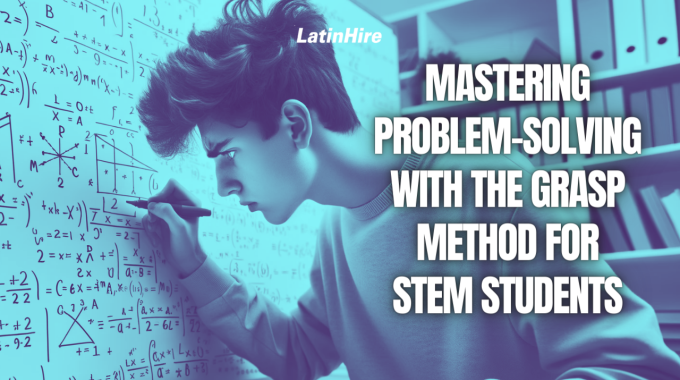In last week’s article, we looked at introducing quantum numbers using a condo analogy as…

Mastering Problem-Solving with the GRASP Method for STEM Students
Problem-solving is a cornerstone skill for all STEM students, whether they’re tackling math, science, engineering or business questions. All of these subject matters involve an abundance of practice problems filled with numbers and variables which can often overwhelm students. They are then left confused as to which formula to use to successfully solve the question.
In this article, we’re going to introduce the GRASP method to simplify problem-solving for your students. GRASP, which stands for Given, Required, Analysis, Solution, and Paraphrase, offers a systematic, step-by-step approach to problem-solving which your students will love.
We’ll provide two sample questions at the end, one simple and one more complex, to show you exactly how to apply this method. You can use your own practice problems while following the same steps when teaching your own students.
Let’s dive in.
1) Given
Start by identifying the given variables in the problem. If there’s a specific number provided, highlight it or write it down, along with an explanation of what the variable represents. This step helps organize what is known in the problem.

2) Required
Carefully reread the question to determine precisely what needs to be solved. What’s the ultimate objective of the question? Identifying the unknown variable to be solved will significantly clarify which formula(s) to apply.
3) Analysis
With the given values and the missing variable in front of you, navigate through your list of formulas to identify the one that will lead you to the desired outcome. Oftentimes, a problem may require the use of two or more formulas, but ensure that, in the end, only one variable remains unsolved, with all other variables either given or solvable from the provided values.
4) Solve
Now that you know exactly which formulas to use, plug in the given values from step 1 and solve the required value in step 2. If you’ve followed the first three steps correctly and accurately input the numbers into your calculator, you should arrive at precisely the final solution.

5) Paraphrase
Conclude the question by expressing the answer in a concise sentence to make it clear that it is your final response to the question.
To illustrate the GRASP method, let’s examine both a simple and a more challenging sample question.
Simple sample question: Amy works at a restaurant and is setting up for a birthday party. There are 45 people attending the party and each table can seat 5 people. How many tables will Amy need to set up?
Given: Number of attendees = 45, Table capacity = 5
Required: Number of tables
Analysis: Number of tables = Number of attendees / Table capacity
Solve: Number of tables = 45 / 5 = 9
Paraphrase: Amy needs to set up 9 tables at the restaurant.
More complex sample problem: David has in his budget $50 for electricity this month. The company he uses to supply his electrical energy charges 11.5¢/kWh. Based on this information, how many kilowatt hours of electrical energy can David use this month?
Given: Budget = $50, Cost of electrical energy = 11.5¢/kWh
Required: Amount (in kWh) of electrical energy that can be used.
Analysis: The units of the budget and cost of electrical energy must match. Convert cents into dollars. You know the formula Total costs = Amount of energy used x Cost per unit of energy. We have Total costs and Cost per unit of energy, so we need to rearrange the formula for Amount of energy used.
Amount of energy used = Total costs / Cost per unit of energy
Solve: Cost per unit of energy in dollars. $1.00 = 100¢
11.5¢ x ($1.00/100¢) = $0.115
Amount of energy used = Total costs / Cost per unit of energy
Amount of energy used = $50 / $0.109/kWh = 435kWh
Paraphrase: David can use 434kWh of electrical energy per month if his budget is $50.

Do you see how much easier it is to solve numerical problems by breaking it down using the GRASP method? Teach this method to your students and help them excel in their STEM courses!
Are there any other methods you use for problem solving? Share them in the comments below!



